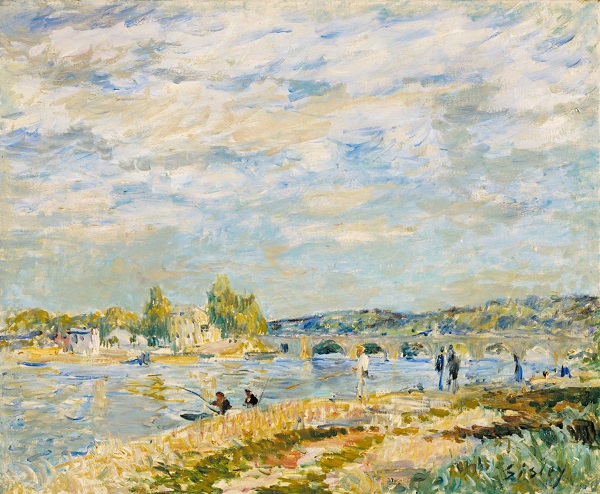
june 17–september 9, 2001
Alfred Sisley
Alfred Sisley (1839-1899) was the most committed Impressionist, remaining faithful to the tenets of direct painting from nature until his death in 1899. His approach to the landscape Impression was graphic rather than painterly: with the exception of a few paintings from the 1870s composed in slabs of color, Sisley preferred to construct his landscapes with small brushes, creating hundreds, sometimes thousands, of colored lines on the canvas, as in The By Road at Roches-Courtaut Woods; St. Martin's Summer. Unlike other Impressionists, Sisley often planned his landscape compositions with pencil and paper before quickly tackling them with canvas, brush, and paint. Sisley's Impressions, such as The Fourteenth of July at Marly-le-Roi and The Seine at Billancourt, with their frenzied and vibrant strokes of color, are some of the boldest works in the exhibition.

Alfred Sisley
The Bridge at Sèvres
1877
Oil on canvas, 38.1 x 46 cm
Tate Gallery, London

The "point" of Impressionist art was to capture the fleeting moment, the transient effect of a certain place, person, or time. Impressionist artists worked on-site with speed and directness, hoping to distinguish their works with a new freshness, immediacy, and truthfulness. Yet the paintings they exhibited were in fact almost always completed in the studio later. This beautifully illustrated book investigates for the first time the works that might truly be called "Impressions"—paintings that appear to be rapid transcriptions of shifting subjects but were nonetheless considered finished by their makers. Renowned Impressionist scholar Richard R. Brettell identifies and discusses Impressions by some of the best-known artists of the period, including Manet, Monet, Renoir, Sisley, Morisot, Degas, Pissarro, and Caillebotte.
The book surveys the various practices of individual artists in the making, signing, exhibiting, and selling of Impressions. Brettell discusses the pictorial theories behind the paintings, the sales strategies for them, and the various forms they took, including works completed in one sitting, "apparent" Impressions, and repeated Impressions. In a concluding chapter, the author considers a small group of works by Vincent van Gogh, who painted with an almost fanatical rapidity and was the only major Post-Impressionist painter to push the aesthetic of the Impression even further.
This book is the catalogue for an exhibition at the National Gallery in London from November 1, 2000, to January 28, 2001, the Van Gogh Museum in Amsterdam from March 2 to May 20, 2001, and the Clark Art Institute from June 17 to September 9, 2001.
240 pages, 9 3/8 x 11 inches
183 color and six black-and-white illustrations
2000
Published in association with Yale University Press
ISBN 0-300-08446-3 (hardcover)
ISBN 0-300-08447-1 (softcover)
